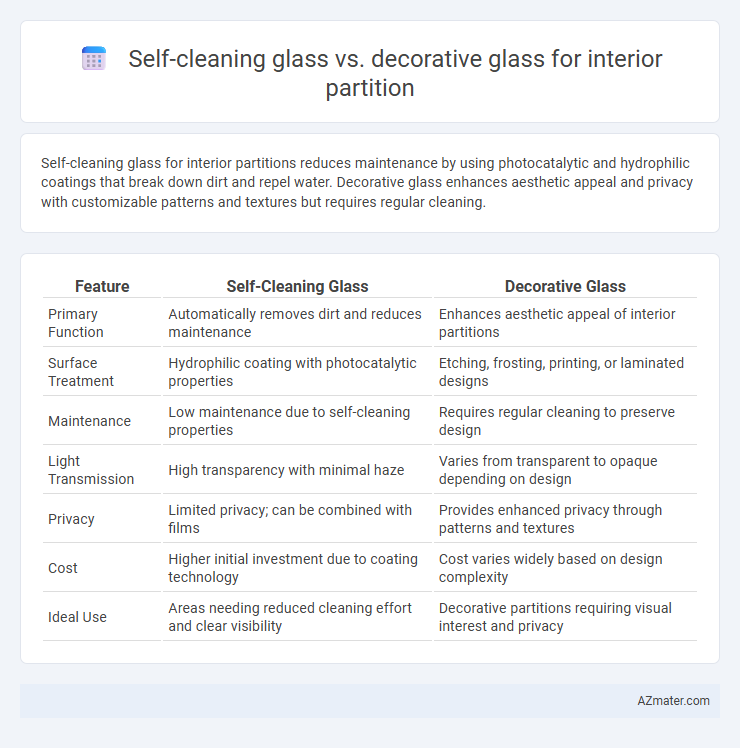Self-cleaning glass for interior partitions reduces maintenance by using photocatalytic and hydrophilic coatings that break down dirt and repel water. Decorative glass enhances aesthetic appeal and privacy with customizable patterns and textures but requires regular cleaning.
Table of Comparison
| Feature | Self-Cleaning Glass | Decorative Glass |
|---|---|---|
| Primary Function | Automatically removes dirt and reduces maintenance | Enhances aesthetic appeal of interior partitions |
| Surface Treatment | Hydrophilic coating with photocatalytic properties | Etching, frosting, printing, or laminated designs |
| Maintenance | Low maintenance due to self-cleaning properties | Requires regular cleaning to preserve design |
| Light Transmission | High transparency with minimal haze | Varies from transparent to opaque depending on design |
| Privacy | Limited privacy; can be combined with films | Provides enhanced privacy through patterns and textures |
| Cost | Higher initial investment due to coating technology | Cost varies widely based on design complexity |
| Ideal Use | Areas needing reduced cleaning effort and clear visibility | Decorative partitions requiring visual interest and privacy |
Introduction to Interior Glass Partitions
Interior glass partitions enhance spatial aesthetics and functionality by offering transparency, light diffusion, and space division. Self-cleaning glass incorporates photocatalytic and hydrophilic coatings that break down organic dirt and enable rainwater to wash away residues, reducing maintenance for high-traffic or hard-to-reach areas. Decorative glass offers customizable designs through frosting, etching, or laminated patterns, providing privacy and visual interest while maintaining the partition's structural benefits.
What is Self-Cleaning Glass?
Self-cleaning glass features a special coating that breaks down organic dirt using sunlight through a photocatalytic process and then allows rainwater to evenly spread and wash away residues, reducing maintenance efforts in interior partitions. Decorative glass, in contrast, primarily focuses on aesthetic appeal with patterns, textures, or colors but lacks the functional self-cleaning properties. Choosing self-cleaning glass enhances durability and cleanliness in spaces where partitions are exposed to dust and fingerprints, improving hygiene and visibility without frequent manual cleaning.
Overview of Decorative Glass
Decorative glass for interior partitions offers a versatile range of designs such as frosted, etched, stained, or patterned surfaces that enhance aesthetic appeal while providing privacy. It can be customized with various textures, colors, and finishes to complement modern or traditional interior styles, making it ideal for offices, homes, and commercial spaces. Unlike self-cleaning glass, decorative glass primarily focuses on visual impact and design flexibility rather than maintenance efficiency.
Key Features: Self-Cleaning vs Decorative Glass
Self-cleaning glass incorporates a special photocatalytic coating that breaks down organic dirt and reduces water residue, ensuring minimal maintenance and clearer visibility over time. Decorative glass for interior partitions offers customizable patterns, textures, and colors, enhancing aesthetic appeal and complementing various design themes. While self-cleaning glass prioritizes functionality and ease of maintenance, decorative glass focuses on visual impact and personalization in interior spaces.
Aesthetic Appeal and Design Flexibility
Self-cleaning glass enhances aesthetic appeal by maintaining a pristine, streak-free surface that reduces maintenance visibility, ideal for sleek, modern interior partitions. Decorative glass offers unparalleled design flexibility with options such as frosted, etched, or colored patterns, allowing for customized privacy and artistic expression. Both materials cater to distinct interior design goals, balancing minimal upkeep with creative freedom.
Maintenance and Cleaning Requirements
Self-cleaning glass significantly reduces maintenance efforts by utilizing a photocatalytic and hydrophilic coating that breaks down organic dirt and allows water to wash it away, minimizing the need for frequent cleaning. Decorative glass for interior partitions, while offering aesthetic appeal with varied textures and patterns, usually requires regular manual cleaning and special care to preserve intricate designs or coatings from damage. Choosing self-cleaning glass enhances long-term efficiency and lowers labor costs, whereas decorative glass demands more attention to maintain its visual quality and surface integrity.
Cost Comparison and Budget Considerations
Self-cleaning glass typically costs 20% to 30% more than decorative glass due to its advanced coating technology that reduces maintenance expenses over time. Decorative glass offers a wider range of design options at a lower initial price, making it suitable for tight budgets focused on aesthetic appeal rather than long-term upkeep. Budget considerations should weigh upfront costs against potential savings in cleaning and durability when choosing between these glass types for interior partitions.
Durability and Longevity
Self-cleaning glass incorporates a special coating that breaks down organic dirt and repels water, significantly reducing maintenance and preserving clarity over time, which enhances its durability in interior partitions. Decorative glass, while offering customizable aesthetics through etching, frosted patterns, or color, often requires more frequent cleaning and may be prone to surface damage, potentially compromising its longevity. The hydrophilic or photocatalytic properties of self-cleaning glass ensure extended lifespan and sustained visual appeal compared to traditional decorative glass options.
Best Applications in Interior Spaces
Self-cleaning glass is ideal for interior partitions in high-traffic areas such as office lobbies, hospitals, and commercial kitchens where maintenance access is limited and hygiene is critical. Decorative glass excels in conference rooms, lounges, and retail spaces, offering customizable patterns, colors, and textures that enhance aesthetic appeal while providing privacy. Combining both types in mixed-use interiors optimizes functionality by balancing easy maintenance with design versatility.
Making the Right Choice for Your Interior Partition
Self-cleaning glass offers practical benefits for interior partitions by reducing maintenance efforts through its hydrophilic and photocatalytic coatings that break down dirt and repel water. Decorative glass enhances aesthetics with a variety of textures, colors, and patterns, making it ideal for adding style and privacy to interior spaces. Choosing between self-cleaning and decorative glass depends on the priority of ease of maintenance versus visual impact in your design concept.

Infographic: Self-cleaning glass vs Decorative glass for Interior partition
 azmater.com
azmater.com